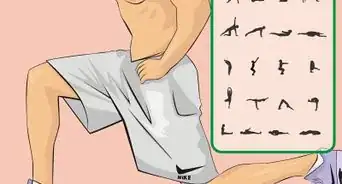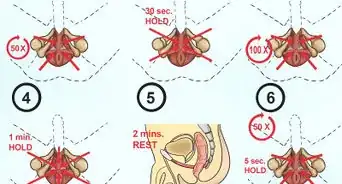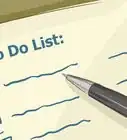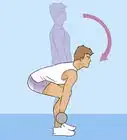This article was co-authored by Laila Ajani and by wikiHow staff writer, Danielle Blinka, MA, MPA. Laila Ajani is a Fitness Trainer and founder of Push Personal Fitness, a personal training organization based in the San Francisco Bay Area. Laila has expertise in competitive athletics (gymnastics, powerlifting, and tennis), personal training, distance running, and Olympic lifting. Laila is certified by the National Strength & Conditioning Association (NSCA), USA Powerlifting (USAPL), and she is a Corrective Exercise Specialist (CES).
There are 26 references cited in this article, which can be found at the bottom of the page.
wikiHow marks an article as reader-approved once it receives enough positive feedback. This article received 41 testimonials and 83% of readers who voted found it helpful, earning it our reader-approved status.
This article has been viewed 7,464,075 times.
Building muscle can boost your confidence, but it takes time and consistency. Fortunately, you can see results if you work hard and stick with it. The key to building muscle is exercising regularly and maintaining a healthy diet. You can build muscles while working out at home or in a gym using the same types of exercises.
Steps
Working Your Muscles
-
1Do pull ups to work your back muscles. Grip a horizontal bar that is comfortably taller than you. Place your hands shoulder-width apart. Then, lift your legs back so that you are hanging from the bar. Pull yourself up, lifting your chin up to the bar using only your arms. Then, lower yourself down to your starting position.[1]
- You can use either an overhanded or underhanded grip.
- Do 3 sets of 10 pull ups.
- This exercise will work your lats, traps, and rhomboids.
-
2Perform bent over rows to build your back. Stand with your feet shoulder-width apart, about 6 to 10 inches (15–25 cm) behind a barbell or 2 dumbbells. Bend slightly at your knees but keep your shins vertical. Bend forward at the waist with your spine and head straight. Lift the weight with an overhand grip up to your lower chest or upper abdomen. Lower slowly until your arms are nearly extended, without touching the ground.[2]
- Do 3 sets of 10 reps.
Advertisement -
3Do bench presses to build your chest and pecs. Start with a weight that you can lift comfortably. If you are a beginner, try lifting the bar along with 5 to 10 pounds (2.3 to 4.5 kg) on each side. Position your arms at shoulder-width apart, then grab onto the bar. Slowly lower the bar until it's at nipple level, then push up until your arms are fully extended upwards.[3]
- Do 3 sets of 8–10 repetitions. If you can, add additional weight each set.
- Once you have a few months of practice, slowly increase the weight and go down to 6–8 reps per set. Try to reach muscle failure at the end of the third set.
Variation: For an added challenge, lift weights on an incline bench press. The incline is like the bench press, but one end of the bench is tilted about 40 degrees. It will be harder to lift the bar on an incline, so start out with less weight than you would on the flat bench-press.
-
4Do push-ups to work your upper body. Get into a plank position with your arms positioned shoulder-width apart. Then, lower yourself down slowly until your chin reaches the floor. Slowly push yourself up to a starting position.[4]
- Do 3 sets of 10 push ups.
- The closer your hands are to one another, the more you'll work your triceps.
- Push-ups are an exercise you can do anywhere.
-
5Do deadlifts to work your thighs, glutes, and calves. Place a heavy barbell or 2 dumbbells on the ground in front of you. Keeping your back straight and your core engaged, slowly bend at your knees. Grasp the weight, then rise from the ground, keeping the weight close to your body. Then, slowly lower the weight back down to the floor.[5]
- Do 3 sets of 10 reps.
- Choose a weight that feels very heavy for you.
- Keep all of your muscles engaged as you do your deadlifts. Use your lower body to help you lift the weights.
EXPERT TIPLaila Ajani is a Fitness Trainer and founder of Push Personal Fitness, a personal training organization based in the San Francisco Bay Area. Laila has expertise in competitive athletics (gymnastics, powerlifting, and tennis), personal training, distance running, and Olympic lifting. Laila is certified by the National Strength & Conditioning Association (NSCA), USA Powerlifting (USAPL), and she is a Corrective Exercise Specialist (CES).Fitness Trainer
 Laila Ajani
Laila Ajani
Fitness TrainerTry microloading to help you gain muscle faster. If you're using barbells, you have the option of loading any weight you want on the side, so you can move your weight up by a pound, or half a pound, or two pounds. If you're able to lift sets of 6 at 50 pounds and it feels kind of heavy, the next week you might try 52 pounds. This will help you see progress really quickly.
-
6Do squats with a weighted bar. Add weights to a barbell, then put it on a rack so that it's a little lower than shoulder height. Duck under the bar and stand up so that the bar rests comfortably just below your neck. Keep your knees slightly bent and your legs slightly wider than shoulder width. Lift the bar up off the rack and move backwards 1 step so that the weight rests on your back. Then, slowly lower yourself down into a squat. Exhale deeply and use your legs and hips to lift out of the squat.[6]
- Do 3 sets of 8 squats.
- The weight should be heavy enough that doing a squat is difficult, but not impossible. If you're a beginner, this may mean using a bar without any weight to start with.
- As you do your squats, keep your chest, knees, and feet aligned vertically with your hips back.
- A 90-degree bend at the knees is the safest option, and make sure your knee doesn't go past your toes.
Variation: Do front squats with a weighted bar for an extra challenge. Rack a weighted bar at just-below shoulder-level. Come up to the bar from the front, positioning the bar on the front shoulders. Cross your arms over onto the bar and walk it out. Keeping your back straight, bend your legs into a squat, with your hips under the bar. Slowly rise back to a starting position.
-
7Do Bulgarian squats with a dumbbell to work your legs. Hold a dumbbell in front of your chest using both hands. Standing in front of a bench, lift your right leg back so that it's parallel to the floor and resting comfortably on the bench. Bend into a squat using your left leg, so that the right knee almost hits the floor. Slowly rise back to your starting position. Repeat on the other side.[7]
- Do 3 sets of 8 reps.
- Bulgarian squats are also called single leg squats.
-
8Do individual bicep curls with dumbbells to work your arms. Sit down on a bench and pick up a dumbbell. Hold your hand in between your thighs. With your elbow resting on your thigh, lift the dumbbell all the way to your upper chest by curling your arm upward. Switch to the opposite hand and repeat.[8]
- Do 3 sets of 8 reps.
Variation: Do bicep curls with a weighted barbell to work both of your arms at the same time. Stand up and grab hold of a weighted bar with both hands. Let your arms extend all the way down to your thighs. Using only your arms, lift the weight up to your chest by curling your arms upward.
-
9Target your triceps with dips. Place your hands shoulder-width apart on a bench, with your body and feet stretched out in front of the bench. Slowly bend your elbows and lower your body down so that your butt nearly touches the floor. Use your arms to lift yourself back to your starting position.[9]
- Do 3 sets of 8 reps.
- If this isn't a high-intensity set for you, increase the resistance by lifting 1 foot off the floor.
- Dips are probably the most effective way to work your triceps, which is the muscle beneath your biceps. You'll need to have strong triceps to bench-press large amounts of weight.
-
10Do skull crushers to work your arms. Lay down flat on a bench with a bar resting on the rack. Lift the bar over you, then bend your elbows so that the bar is close to your forehead. Slowly push the bar up until your arms are fully extended. Then, bring the weight back down. Keep your elbows close together as you lift and lower the bar.[10]
- Repeat for 3 sets of 8 reps.
-
11Do an overhead press to build your shoulders. Hold a barbell or 2 dumbbells at chest or shoulder height, with your palms facing forward. Lift the weight above your head until your arms are fully extended. Keep your elbow slightly bent to prevent hyperextension. Then, slowly lower the weights back to the starting position.[11]
- Do 3 sets of 8 reps.
Variation: You can switch up this exercise by changing your hand and palm position. If you're using dumbbells, you can lift them until they touch overhead or lift them into a wide "Y" shape with your arms.
-
12Do crunches to work your abs and core muscles. Lie down on a mat and position both arms behind your head without locking your hands. Bend your knees so that your feet are flat on the ground. Push the small of your back into the ground and slowly roll your shoulders off the ground slightly. Then, slowly return to the floor.[12]
- Repeat for 3 sets of 20 reps.
- Keep your movements slow and steady.
Variation: For oblique crunches, angle your torso so 1 shoulder reaches toward the opposite knee. Alternate sides after each crunch.
-
13Do planks to work your abs and core. Lie face-down on the floor. Place your hands under your shoulders. Then, lift yourself up so that your body is still parallel to the floor. Keep your body straight and hold your position for as long as possible.[13]
- Try to hold your plank for 2 minutes. If you can't, rest for 1-2 minutes, then do a plank again. Do as many planks as it takes to reach 2 minutes.
- If you can't support yourself on your arms, you can modify this exercise by resting on your forearms instead.
Establishing Your Exercise Routine
-
1Build an exercise routine. Write out a workout plan for yourself so that you know what days you will work each muscle group. You can choose to work them all on the same day, or you can work them on different days. Be sure to rest your muscle groups 24-48 hours between workouts.[14]
- For instance, if you workout your arms on Monday, don't work them again until Wednesday or Thursday.
- If you're not sure where to begin, find a solid workout program online and try it out for a while. Don't immediately jump from one program to the next or you may prevent yourself from making steady progress.
- Do 5 reps for muscle strength. 6-12 reps for muscle strength and increase in muscle size. Above 12 reps for muscle endurance. Do 3-5 sets for increase in muscle size.
-
2Schedule your workouts. To avoid over-training, set up a schedule that works for you and your goals. Organize your routine so that you can work two muscle groups simultaneously and save time (supersetting). Examples could be a chest and back day, bicep and tricep day, or a chest and bicep day.
- Here is an example of a split routine that gives you plenty of time to break down your muscles, and plenty of time off to let them recover:
- Day 1: Chest and biceps, followed by cardio
- Day 2: Back and triceps
- Day 3: Rest and cardio
- Day 4: Legs and abs
- Day 5: Shoulders, followed by cardio
- Day 6: Rest
- Day 7: Rest
- Another routine you can try is an upper/lower split. Here's a schedule you can use:
- Day 1: Upper-body workout, followed by cardio
- Day 2: Lower-body workout
- Day 3: Rest and cardio
- Day 4: Upper-body workout
- Day 5: Lower-body workout
- Day 6: Rest and cardio
- Day 7: Rest
- Here is an example of a split routine that gives you plenty of time to break down your muscles, and plenty of time off to let them recover:
-
3Warm up with cardio exercise before you lift weights. Before you begin any exercise routine, start with a low-intensity routine designed to warm up all the muscles you're about to work on. Not only will it help you get into the right frame of mind, it can help prevent injuries. Do 5-10 minutes of light cardio before you start lifting weights.[15]
- For instance, walk, run, or jog in place.
- Don't warm up with stretches unless you've already done at least 5 minutes of cardio. You should never stretch cold muscles, which can lead to injury.
-
4Work out harder for a shorter length of time to build muscle. Training with high reps is good for building endurance, but it won't help you build up either size or strength. Instead, aim for about 3-8 sets per muscle group, and 6-12 reps per set for your normal routine. Your final rep should be very hard to complete! If it's not, increase the weight you're lifting.[16]
- Cap your workout time at 60 minutes a day. Any longer and you'll be too fatigued to perform any more quality sets.
Tip: Every 4-8 weeks, vary your routine. As your body adapts to stress, you'll hit a plateau where the benefits of weight training will begin to diminish. The only way to prevent this from happening is to change things up, such as by increasing weight and changing exercises.
-
5Work your whole body over the week. You'll see the maximum benefit when your entire body is part of the routine. The more muscles you use when training, the more strength you'll gain and the more balanced your muscle development will be. You can work your whole body at 1 time or target different muscle groups on different days.[17]
- Give all muscle groups equal attention, such as five sets of rows after five sets of bench presses. This will encourage balanced training, growth, and flexibility.
- Compound exercises such as squats, deadlifts, presses, rows, and pull-ups use a lot of different muscles. They're great for a full-body workout.
- Don't rush. Advanced lifters often base their routines around a technique called explosive repetition. In other words, they lift a tremendous amount of weight in a short (explosive) amount of time. There are significant benefits to this method, but the risk of injury in novice athletes is high. It is recommended solely for more advanced athletes.
-
6Include cardio training. The standard recommendation is 150 minutes of moderate cardio each week, or 75 minutes of vigorous cardio, or an equivalent combination of the two. A good place to start would be doing 30-60 minutes of cardiovascular activity every other day or 3 times a week. Examples of cardio include running, biking, swimming, and any sport that involves constant movement.[18]
- Good cardiovascular health improves blood flow, a requirement for muscle growth. Doing cardio also improves your cardiovascular fitness, which allows you to use your muscle gains for various sports and activities.
- Cardio burns calories quickly, so overdoing it can limit the energy available to build your muscles. If you increase the amount of cardio exercise you do, be sure to increase your calorie intake as well.
-
7Get your rest. Your body needs time to recover, and to repair (build) your muscles, and to do that you will need at least 8 hours of quality sleep a night. Additionally, don't overdo your training regimen. You can reach a point known as "over-training," in which you'll lose the ability to "pump" your muscles, which can lead to muscle wasting. Here are some symptoms to be aware of if you think you may be falling into the over-training zone:[19]
- Chronic fatigue
- Strength loss
- Loss of appetite
- Insomnia
- Depression
- Lowered sex drive
- Chronic soreness
- Prone to injury
-
8Lower your stress levels. Whether your stress comes from your job, home, or just the way you're wired, do what you can to reduce or eliminate it. It's not just good for you in general, but stress also increases the production of the hormone cortisol, which encourages your body to store fat and burn muscle tissue. Here are some ways to reduce stress:[20]
- Take a walk.
- Talk to a friend.
- Journal.
- Color in an adult coloring book.
- Play with your pet.
- Soak in a bathtub.
- Smell essential oils.
-
9Practice explosive lifts to build strength. "Exploding" upward while lifting trains your muscles for quick, explosive strength. However, this increases the risk of injury if you do not use the correct technique. If you want to add these to your squats or other range of motion exercises, practice first with a lighter weight and a low-intensity set up:[21]
- Work up to the explosive part of the move gradually by starting with a smaller range of motion, and increase it with time and practice.
- Move slowly on the eccentric (the lowering phase). This is the part of motion which causes the most tearing, so don't try to "explode" downward.
- "Load the muscle" at the low point of the exercise. This means holding the muscle contraction before beginning the movement.
- Explode upward quickly, but avoid full extension at the peak range of motion. For example, knees should stay slightly bent for leg exercises, and elbows slightly bent for upper body exercises.
Eating a Healthy Diet
-
1Increase your calorie consumption by 10%. Keep a log of the number of calories you eat, and use the average of those numbers to estimate your daily caloric needs. Then, multiply that number by 1.1. Make sure your calories are coming from a variety of healthy, minimally processed foods to provide quality nutrients for muscle-building.[22]
-
2Get enough protein to support muscle growth. Aim for about 0.8 grams to 1 grams of protein per pound of bodyweight (1.6g to 2g per kg). For example, if you weigh 180 lb, take in 144-180 g of protein every day. If you're overweight, use your lean body mass as your bodyweight instead of your current weight.[23]
- One ounce (28 grams) of cooked meat contains roughly 7 grams of protein.[24] You could meet a 120-gram daily goal with three 6-oz. steaks, assuming no other protein sources.
- If you're having difficulty meeting these protein levels, you can always use protein shakes to make up the difference.
-
3Drink at least 8 cups (1.9 L) of water each day. The body needs a sufficient amount of water to build muscle at an optimal rate. Aim to drink at least 8 cups (1.9 L), but you'll likely need more to build healthy muscle. Here's a great little formula to help make sure you are getting enough:[25]
- Imperial units: Bodyweight in lbs X 0.6 = water intake in ounces.
- The same formula in metric units: Bodyweight in kg x 40 = water intake in milliliters.
- This includes all water from food and drink, not just glasses of water.
- If you are over 30, you can lower these numbers to lbs x 0.46 to 0.54, or kg x 30 to 35.
-
4Eat regular meals at the same time each day. Rather than having 2-3 large meals during the day, change your eating habits so that you are eating 5-7 smaller meals during the day.[26]
- To help keep your protein intake high, you may want to make 1 of your meals a protein shake. To make a basic shake, blend 8 ounces (230 g) skimmed milk, 1 banana, 1 tablespoon (15 ml) peanut butter, and 2 scoops of protein powder.
-
5Eat healthy fats. Not only does it make food taste good, fat is also good for you, as long as you are eating the right kinds and amounts of fat! Saturated fats—the fat you'll find in a stick of butter, a bag of chips, or bacon—should be limited to about 20g or less. However, increase the amount of healthy fats that you eat, such as monounsaturated fats and polyunsaturated fats.[27]
- A good way to determine how much fat in grams you should be taking in is to multiply your calorie intake by 0.008 for maximum saturated fats and by 0.03 for the "good fats." For example, for a 2,500-calorie diet, you would limit saturated fats to 20g or less and up to 75g of mono- and polyunsaturated fats.
- Fat is necessary for the proper distribution of vitamins A, D, E, and K, helps promote better eyesight, and promotes healthy skin. Fats are also important for the synthesis of hormones, so maintaining an adequate intake of them will speed up muscle-building and recovery.
- Monounsaturated fats can be found in olive, canola, and sesame oils; avocado; and nuts such as almonds, cashews, peanuts, and pistachios.
- Polyunsaturated fats are found in corn, cottonseed, and safflower oils; sunflower seeds and oils; flaxseed and flaxseed oil; soybeans and soybean oil.
- Omega-3 fats, an overall winner of a fat that is very beneficial to heart and blood health, eyesight, and for children, brain development. You'll find this fat in many omega-3-enriched foods. Another great source is fatty cold-water fish such as salmon, tuna, trout, and sardines.
-
6Take a multivitamin, if your doctor recommends it. In addition to a well-balanced diet, include a multivitamin supplement in your diet. It will ensure that your body is getting the full amount of vitamins and minerals it needs to stay healthy. There are many options, depending on your age, your sex, and your particular health and diet needs. Find the one that's right for you, and make it part of your daily routine.[28]
- Alternatively, you can also consider taking specific supplements, such as glutamine, instead of a general multivitamin.
- Always check with your doctor before taking any vitamins or supplements.
Can Stretching Impact Your Ability to Gain Muscle?
Exercise, Routine, and Foods to Eat and Avoid to Build Muscle
Expert Q&A
Did you know you can get expert answers for this article?
Unlock expert answers by supporting wikiHow
-
QuestionHow do you maintain a strong, healthy back?
 Ashley Mak, DPTAshley Mak is a Physical Therapist and the Owner of Ashley Mak Performance and Rehabilitation, his physical therapy business based in Hoboken, New Jersey. He is also the CEO of Hudson River Fitness and an Adjunct Professor at Kean University. With over seven years of physical therapy experience, Ashley specializes in both pain management and maximizing physical performance. He received his BA in Biology from Villanova University in 2010 and his Doctorate in Physical Therapy (DPT) from Thomas Jefferson University in 2012.
Ashley Mak, DPTAshley Mak is a Physical Therapist and the Owner of Ashley Mak Performance and Rehabilitation, his physical therapy business based in Hoboken, New Jersey. He is also the CEO of Hudson River Fitness and an Adjunct Professor at Kean University. With over seven years of physical therapy experience, Ashley specializes in both pain management and maximizing physical performance. He received his BA in Biology from Villanova University in 2010 and his Doctorate in Physical Therapy (DPT) from Thomas Jefferson University in 2012.
Physical Therapist
-
QuestionCan skinny guys build muscle?
 Michele DolanMichele Dolan is a BCRPA certified Personal Trainer in British Columbia. She has been a personal trainer and fitness instructor since 2002.
Michele DolanMichele Dolan is a BCRPA certified Personal Trainer in British Columbia. She has been a personal trainer and fitness instructor since 2002.
Certified Fitness Trainer
-
QuestionHow can I grow biceps fast?
 Michele DolanMichele Dolan is a BCRPA certified Personal Trainer in British Columbia. She has been a personal trainer and fitness instructor since 2002.
Michele DolanMichele Dolan is a BCRPA certified Personal Trainer in British Columbia. She has been a personal trainer and fitness instructor since 2002.
Certified Fitness Trainer
Warnings
- Don't be intimidated or make assumptions when you see someone using a different amount of weight than you. They may be on a program in which they are doing fewer reps with more weight, or vice versa. Building muscle has nothing to do with how much someone else is lifting; it has to do with how much you're challenging yourself.⧼thumbs_response⧽
- You need not visit a gym to build muscles. You can even build muscles naturally by controlling your diet and through strength exercise.⧼thumbs_response⧽
- If you are a beginner, start with lighter weights. Trying to lift heavier weights than you can handle can lead to injury.⧼thumbs_response⧽
References
- ↑ https://www.coachmag.co.uk/exercises/full-body-workouts/2534/10-pull-variations
- ↑ https://www.coachmag.co.uk/exercises/back-exercises/177/bent-over-row
- ↑ https://www.nerdfitness.com/blog/what-do-you-bench-strength-training-101-the-bench-press/
- ↑ https://www.nerdfitness.com/blog/proper-push-up/
- ↑ https://www.stack.com/a/the-dos-and-donts-of-the-deadlift-and-back-squat
- ↑ https://www.stack.com/a/the-dos-and-donts-of-the-deadlift-and-back-squat
- ↑ https://www.coachmag.co.uk/leg-exercises/199/bulgarian-split-squat-instructions-form-tips-and-variations
- ↑ https://www.mensjournal.com/health-fitness/10-different-ways-do-curl/
- ↑ https://www.stack.com/a/dips
- ↑ https://www.youtube.com/watch?v=d_KZxkY_0cM
- ↑ https://www.coachmag.co.uk/exercises/shoulder-exercises/203/perfect-the-shoulder-press
- ↑ https://www.youtube.com/watch?v=5ER5Of4MOPI
- ↑ https://www.mensjournal.com/health-fitness/how-to-do-a-plank-a-single-move-for-stronger-abs/
- ↑ https://www.nerdfitness.com/blog/how-to-build-your-own-workout-routine/
- ↑ https://www.self.com/gallery/best-5-minute-warm-up-strength-workout
- ↑ https://www.wellandgood.com/good-sweat/short-workouts-vs-long-workouts-more-effective/
- ↑ https://www.mayoclinic.org/healthy-lifestyle/fitness/in-depth/fitness-training/art-20044792
- ↑ https://www.mayoclinic.org/healthy-lifestyle/fitness/in-depth/fitness-training/art-20044792
- ↑ https://www.mayoclinic.org/healthy-lifestyle/fitness/in-depth/fitness-training/art-20044792
- ↑ https://www.health.harvard.edu/staying-healthy/exercising-to-relax
- ↑ https://www.mensjournal.com/health-fitness/12-best-moves-increase-explosiveness/
- ↑ http://relentlessgains.com/macronutrient-ratio-for-lean-muscle-gains-bulking-macros/
- ↑ https://www.coachmag.co.uk/nutrition/6839/how-to-maximise-the-muscle-building-effects-of-protein
- ↑ https://und.edu/student-life/dining/_files/docs/fact-sheets/protein.pdf
- ↑ https://www.ncbi.nlm.nih.gov/pubmed/30055008
- ↑ https://www.mayoclinic.org/healthy-lifestyle/nutrition-and-healthy-eating/expert-answers/underweight/faq-20058429
- ↑ https://www.medicalnewstoday.com/articles/321518.php
- ↑ https://www.coachmag.co.uk/nutrition/healthy-eating/1263/12-best-nutrients-and-vitamins-building-muscle-and-burning-fat
About This Article
To build muscle, aim to work out for 30-60 minutes, 3-5 times a week. However, when you do work out, aim for shorter reps and more weight, which is the best way to build bulk. Additionally, try to vary your routine every month or so by switching up which exercises you're doing, which will help prevent you from plateauing. Make sure you're doing exercises that target the muscles you want to build! If you want to build your back muscles, focus on doing exercises like bent-over rows, pull-ups, and deadlifts. For your pecs, do exercises like push-ups, bench presses, and dips. You'll also want to spend time building your leg muscles with exercises like squats, deadlifts, and lunges. And don't forget about your abdominal muscles, which you can build by doing crunches, planks, and sit-ups. To help your muscles grow, try to finish your workout by drinking a whey protein shake, and eat 3-4 large meals on days that you exercise. For advice from our Personal Trainer co-author, like how to eat healthy to build muscle, keep reading!

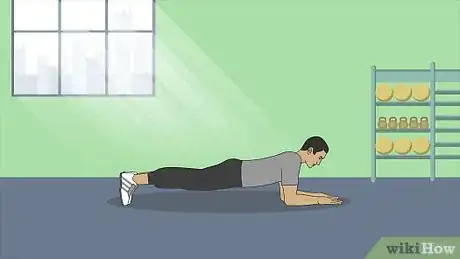
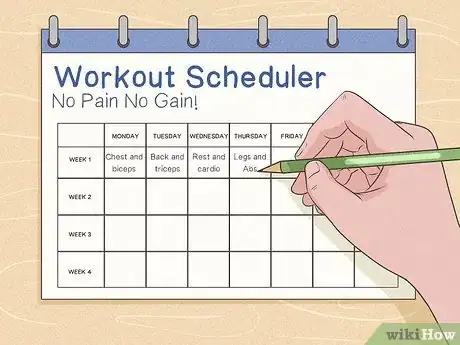
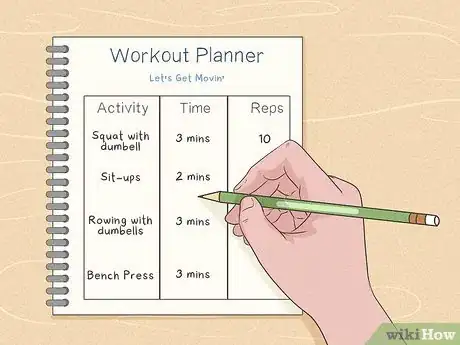
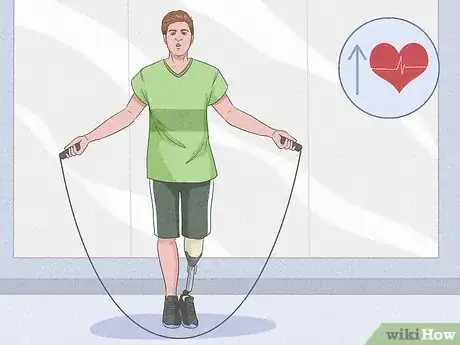
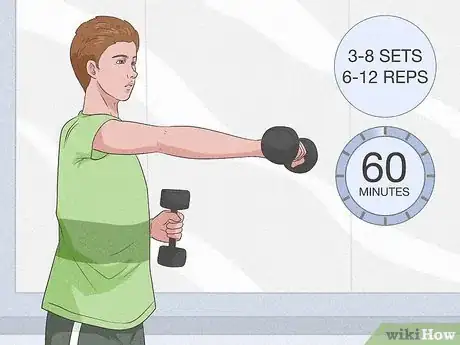
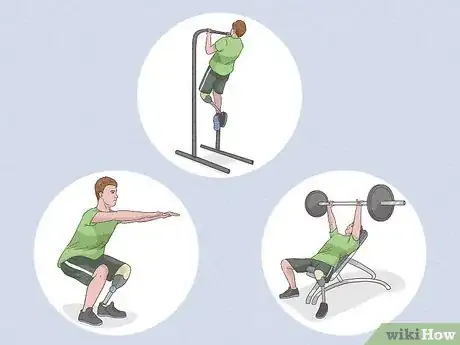
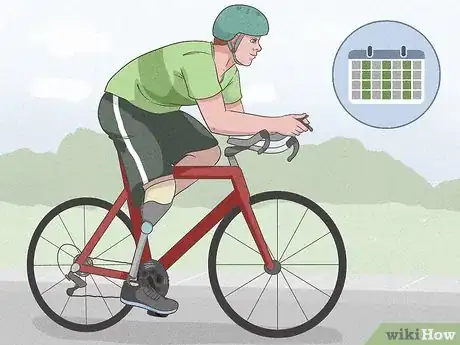
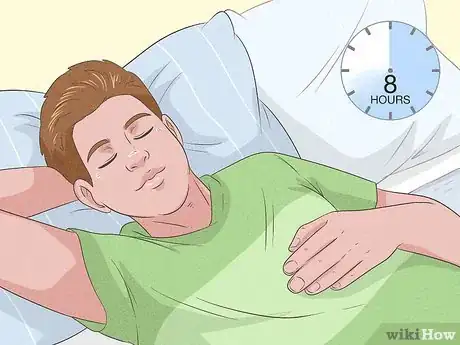

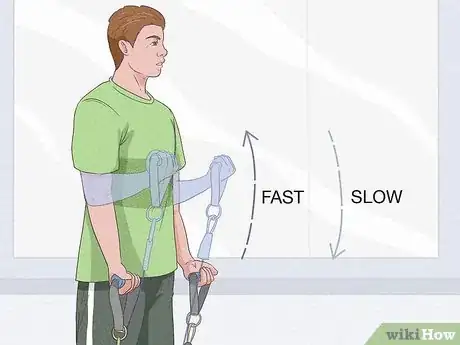
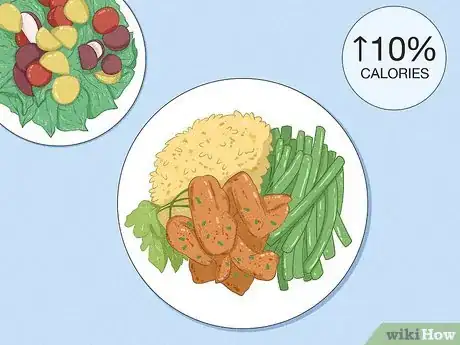
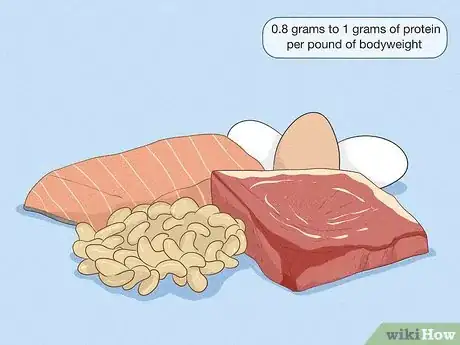
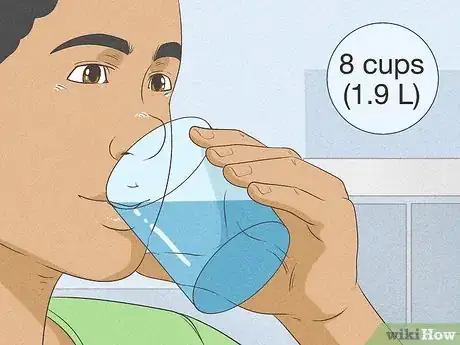
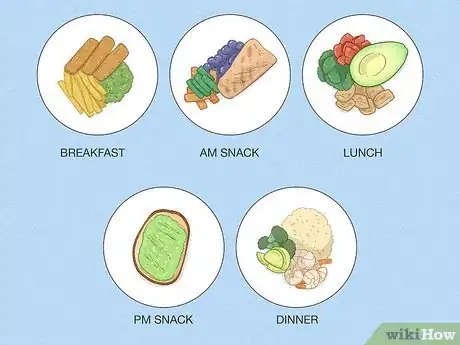
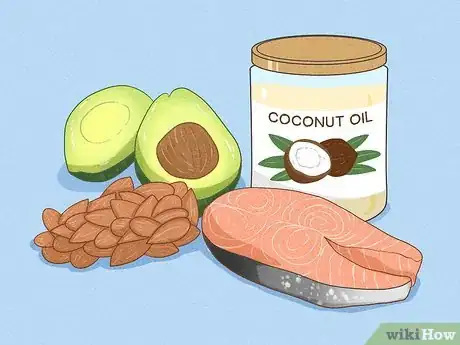

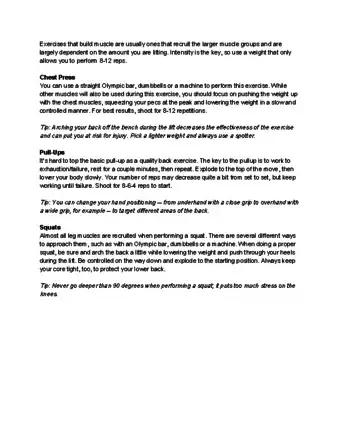
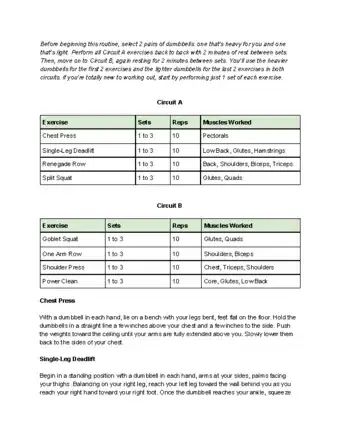
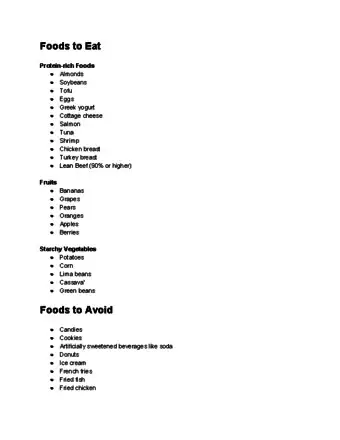




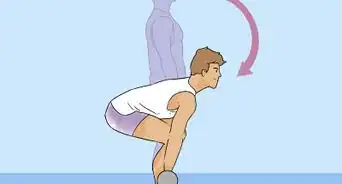
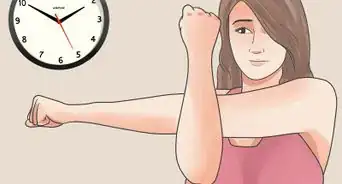
-Step-24.webp)
-Step-12-Version-2.webp)
